Chloroplast in a plant cell exists as a membrane-bound cell organelle and contain chlorophyll pigments that are absent in the animal cells. The study of chloroplast was first carried by a scientist named Hugo Von Mohl in the year 1837.
After his study, it was found that the chloroplasts were the type of plastids and named “Chloroplastids” by scientist Schimper in 1883. Then, Eduard Strasburger coined the term “Chloroplast” in 1884.
On further study, it was found that the chloroplasts have evolved from the cyanobacteria through a process of endosymbiosis. The morphology of chloroplast had shown considerable resemblance with the cyanobacteria and was later considered as the ancestors of cyanobacteria.
This evolution of the chloroplast from the endosymbiosis of cyanobacteria was introduced in 1905 by a scientist named Konstantin Mereschkowski. This post discusses the definition, general characteristics, structure, location and functions of the chloroplast.
Content: Chloroplast in Plant Cell
Definition of Chloroplast
Chloroplast is a type of plastid, which exists as a double membrane-bound cell organelle that produces energy through photosynthesis. Chloroplasts show “dimorphism” as they can exist in two different forms, namely granal and agranal.
Granal kind of chloroplast comprises all the elements like grana, stroma and stroma lamellae in the internal membrane. Agranal kind of chloroplast lacks grana and only contains stroma and stroma lamellae within the inner layer.
Characteristics of Chloroplast
Let us look into some general characteristics of a chloroplast by knowing its size, shape and number.
Size of Chloroplast
Chloroplasts possess variable size that differs from one plant to other. The length of the chloroplast ranges 5-10 micrometres, and the diameter ranges 2-4 micrometres.
Shape of Chloroplast
Chloroplast’s shape also differs among different photosynthetic organisms.
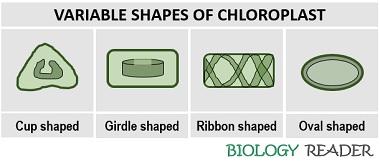
- Cup-shaped chloroplast: Chlamydomonas comprises a cup or horseshoe-shaped chloroplast.
- Girdle shaped: Ulothrix contains a chloroplast in the middle of the vegetative cell.
- Ribbon shaped: Spirogyra contains a filamentous or band-like chloroplast.
- Discoidal shaped: Higher plants have an oval or biconvex chloroplast, which is the most common type.
Number of Chloroplasts
The number of chloroplasts varies between different photosynthetic organisms.
- Chlamydomonas and Ulothrix species have one chloroplast per cell.
- Spirogyra contains 1-16 chloroplasts per cell.
- The number of chloroplast increases in higher plants that contain 20-40 chloroplasts per cell.
- Chara contains 500 chloroplasts per cell.
Video: Chloroplast in Plant Cell
Structure of Chloroplast
A chloroplast is a kind of plastid, which is a double membrane-bound organelle and consists of the following structural elements:
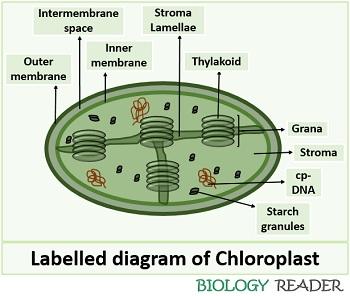
- Outer membrane: It is a smooth layer, which contains less protein and shows more permeability towards the passage of small molecules or ions.
- Inner membrane: It is also a smooth layer. Inner chloroplast membrane contains more protein and serves as a selectively permeable membrane, i.e. allows specific molecules to enter inside the cell.
- Intermembrane space: It represents the space in the middle of an outer and inner chloroplast membrane, having a 10-20 nm thickness.
- Stroma: It exists as the colourless, alkaline, aqueous liquid that encloses the internal membrane structures like thylakoid and lamellae. The region of the stroma is rich in enzymes and contains coiled circular DNA and dispersed starch granules. Likewise, mitochondrial cell chloroplast also functions as “Semi-autonomous” by having its own circular DNA (cp-DNA) and ribosomes of 70-S type (Plastidozomes).
Specialized part
Chloroplasts possess a specialized part (thylakoid) where the chlorophyll pigments are embedded.
Thylakoid: It appears sac-like. The aqueous stroma surrounds the thylakoid sacs. Thylakoids are usually arranged one over the other, like a pile of coins, called “Grana”. The stroma lamellae or intergrana holds the stack-like grana together. Thylakoid membrane surrounds the thylakoid and comprises a unit of “Quantosome”.
All the 230 pigments like chlorophyll, carotenoids, xanthophyll and phycobilins in the thylakoid space collectively constitute the quantosome. A fluid occupied in the space or middle of the thylakoid membrane is called a thylakoid lumen. The pigments in the thylakoid membrane absorb light of a particular wavelength from the sun and pass it to the light-harvesting complexes (PS-I and PS-II).
Thylakoid comprises of two parts, namely appressed and non-appressed part.
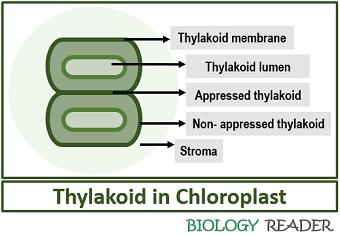
- The region of the thylakoid membrane which is in contact with the aqueous stroma contributes to the “Non-appressed part”. It contains a photosystem-I.
- The region of the thylakoid membrane which is in contact with the other thylakoid membrane contributes to the “Appressed part”. It contains a photosystem-II.
Stroma lamellae: They exist as the tubular structures formed by the invagination of the inner chloroplast membrane. Lamellae act as a skeleton of chloroplast by maintaining a proper distance between thylakoids or protect from overlapping.
Location of chloroplast in plant cell
Chloroplasts are the essential cell organelles in a plant cell located within the leaves’ mesophyll cells. Mesophyll cells consist of:
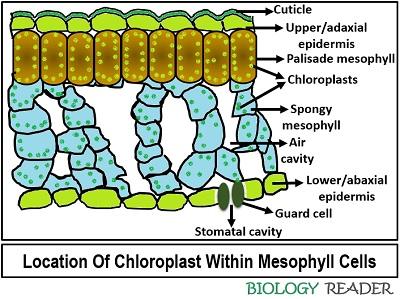
- Palisade parenchyma
- Spongy parenchyma
Palisade parenchyma is the upper layer that contains a high number of chloroplasts within the broad and elongated chlorenchymatous cells. Spongy parenchyma is the lower layer containing fewer chloroplasts within small, ovoid cells and having prominent intercellular spaces.
Functions of Chloroplast in plant cell
A chloroplast performs three significant tasks:
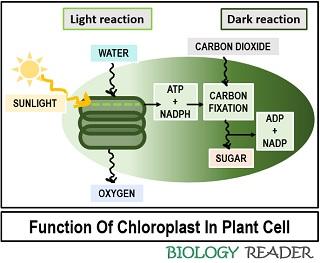
Role in photosynthesis: Chloroplast acts as a location of photosynthetic activity, where the chlorophyll pigments inside it trap the light energy to transform it into chemical energy.
The light reaction of photosynthesis, i.e. conversion of H2O into O2, occurs in the thylakoid by releasing ATP and NADPH. Dark reaction or the fixation of CO2 into sugar takes place in the stroma by producing ADP and NADP.
Energy metabolism: The oxidation of water molecules releases ATP and NADPH energy molecules. Plant cells utilize these high energy molecules to convert the CO2 into three-carbon sugar. Glyceraldehyde 3-phosphate is a three-carbon sugar that helps to build a variety of carbohydrates and other organic molecules.
After reduction of CO2 into sugar, hydrolysis of ATP and NADPH molecules occurs that eventually release ADP and NADP. Thus, chloroplast drives some of the energy to break down carbohydrates and facilitate other cellular processes.
Food storage: In chloroplast, the dispersed starch granules within the aqueous stroma act as food storage molecules granules.
Thank you for the good and interesting information.